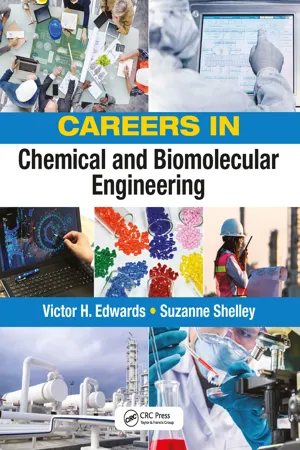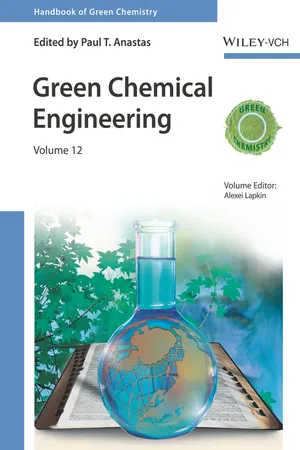Technology & Engineering
Chemical Engineering
Chemical engineering involves applying principles of chemistry, physics, and mathematics to design and operate processes that convert raw materials into valuable products. This field plays a crucial role in various industries, including pharmaceuticals, food and beverage, energy, and environmental sustainability. Chemical engineers work on developing efficient and sustainable processes, optimizing production, and ensuring safety and environmental compliance.
Written by Perlego with AI-assistance
Related key terms
4 Key excerpts on "Chemical Engineering"
- eBook - ePub
- Jack Hipple(Author)
- 2017(Publication Date)
- Wiley-AIChE(Publisher)
1 What Is Chemical Engineering?There are no doubt numerous dictionary definitions of Chemical Engineering that exist. Any of these could be unique to the environment being discussed, but all of them will involve the following in some way:- Technology and skills needed to produce a material on a commercially useful scale that involves the use of chemistry either directly or indirectly. This implies that chemistry is being used at a scale that produces materials used in commercial quantities. This definition would include not only the traditional oil, petrochemical, and bulk or specialty chemicals but also the manufacture of such things as vaccines and nuclear materials, which in many cases may be produced in large quantities, but by a government entity without a profit motive, but one based on the welfare of the general public.
- Technology and skills needed to study how chemical systems interact with the environment and ecological systems. Chemical engineers serve key roles in government agencies regulating the environment as well as our energy systems. They may also serve in an advisory capacity to government officials regarding energy, environmental, transportation, materials, and consumer policies.
- The analysis of natural and biological systems, in part to produce artificial organs. From a Chemical Engineering standpoint, a heart is a pump, a kidney is a filter, and arteries and veins are pipes. In many schools, the combination of Chemical Engineering principles with aspects of biology is known as biochemical or biomedical engineering.
- Thermodynamics. This topic relates to the energy release or consumption during a chemical reaction as well as the basic laws of thermodynamics that are universally studied across all fields of science and engineering. It also involves the study and analysis of the stability of chemical systems and the amount of energy contained within them and the energy released in the formation or decomposition of materials and the conditions under which these changes may occur.
- eBook - ePub
- Victor Edwards, Suzanne Shelley(Authors)
- 2018(Publication Date)
- CRC Press(Publisher)
1 What Are Chemical Engineering and Biomolecular Engineering?“Scientists investigate that which already is; engineers create that which never has been.” Albert EinsteinLoosely paraphrased: “Science is what is... Engineering is what you want it to be.”Science and Engineering: Two Essential and Related DisciplinesChemists study matter and its transformation into its different forms, and create new chemicals, including chemicals of great potential value. They also devise ways to synthesize those chemicals; first, they do this in laboratory-scale quantities, often with the help of new catalysts. Then chemists work with others (including chemical engineers and those in related disciplines) to scale up these discoveries to produce commercial-scale quantities using processes that are deemed safe and environmentally and economically viable. Chemists are increasingly seeking to apply principles of “green chemistry” the practice of creating new chemicals and chemical reactions that are benign in terms of their ultimate impact on personnel and the environment.By contrast, chemical engineers play an integral role in taking promising chemistry-related discoveries and devising the necessary engineering, safety, and control systems to produce them on a commercial scale, both safely and economically, with minimal impact to the environment. Such professionals use the full range of Chemical Engineering principles to design, build, and manage industrial-scale process plants that are needed to safely and sustainably produce the needed quantities of useful chemicals and related products for society with minimum impact on the environment. Figure 1.1 shows several chemical plants on the coast of the Netherlands.Figure 1.1This aerial view shows several chemical process plants in the Netherlands. Chemical engineers and biomolecular engineers find a diverse array of employment opportunities at these types of facilities, which rely on all aspects of these technical disciplines to transform raw materials into finished products in a safe, efficient and economical way. (Source: Shutterstock ID 717938881, 7 August 2017, Moerdijk, Holland. Aerial view of industrial area with Shell Chemicals Attero and Essent. On the clear horizon a sky with clouds and river Hollands Diep) - eBook - ePub
- Dmitry Yu. Murzin(Author)
- 2015(Publication Date)
- De Gruyter(Publisher)
Chapter 1Chemical technology as science
1.1 Basic principles
Chemical technology can be defined as a science of converting natural resources or other raw materials into the desired products at the industrial scale using chemical transformations in a technically and economically feasible and socially acceptable way. Besides being based on sound economical considerations, chemical production should nowadays take into account ecological aspects, safety requirements, and labor conditions.Chemical technology investigates chemical processes (whose structures had been given in Fig. 1.1 ), which comprise feed purification, reactions per se , separation, and product purification.Chemical technology is not limited only to chemical transformations per se , as there are other various physical, physico-chemical, and mechanical processes in the production of chemicals.Criteria of a process quality are technological parameters (productivity, conversion, yield, product purity) as well as economical (costs, profitability, etc.) and ecological ones. Success in implementation of a novel technology requires its robustness, reliability, safety, environmental compliance as well as significant gains over existing processes. Methods of chemical technology are used also in non-chemical industries, such as transport, metallurgy, building construction, electronic industry. Chemical technology as a discipline is based on the following:- – Physical chemistry and chemical reaction engineering, covering stoichiometry, thermodynamics, mass transfer, kinetics, and various types of catalysis
Fig. 1.1 :
- eBook - ePub
- Paul T. Anastas(Author)
- 2018(Publication Date)
- Wiley-VCH(Publisher)
Table 1.3 ), access to bulk chemical products or fossil energy are not on the list, but clean water, renewable energy, carbon sequestration, and better medicines are. I would argue that solutions to these challenges require much closer integration of Chemical Engineering with the neighboring sciences, and developing the capability for transcending many length scales that connect molecular systems with manufacturing systems and the final applications. These trends – (i) of merger of Chemical Engineering with physical, biological, and medical sciences and (ii) setting much broader system boundaries for problems – are evident in current Chemical Engineering literature and the subject matter of research in leading Chemical Engineering departments in universities around the world.NAE 2017 grand challenges for engineering [52].Table 1.3Make solar energy economical Provide energy from fusion Develop carbon sequestration methods Manage the nitrogen cycle Provide access to clean water Restore and improve urban infrastructure Advance health informatics Engineer better medicines Reverse engineer the brain Prevent nuclear terror Secure cyberspace Enhance virtual reality Advance personalized learning Engineer the tools of scientific discovery Recently, several publishers launched journals that are explicitly aimed at the interdisciplinary space between sciences and Chemical Engineering. These include ACS Sustainable Chemistry and Engineering, RSC's Reaction Chemistry and Engineering, RSC's Molecular Systems Design and Engineering, Elsevier's Sustainable Chemistry and Pharmacy, and so on, as well as the already well-established interdisciplinary chemistry–Chemical Engineering–material science journals, such as ChemSusChem and Green Chemistry
Learn about this page
Index pages curate the most relevant extracts from our library of academic textbooks. They’ve been created using an in-house natural language model (NLM), each adding context and meaning to key research topics.



